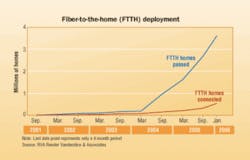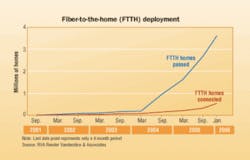Researchers say the latest numbers of fiber-to-the-home deployments show strong growth, with deployments increasing across all market segments.
The numbers are being touted by the Fiber-to-the-Home Council (www.ftthcouncil.org) and Telecommunications Industry Association (www.tiaonline.org). Both organizations are pointing to the latest estimates from Render, Vanderslice & Associates, LLC (www.rvallc.com), which indicate that FTTH deployments are now passing over 3.6 million U.S. homes-an increase of almost 1 million homes in four months. The figures show the most rapid growth of FTTH deployment to date, with more than 230,000 additional homes passed every month.
“It’s really just accelerating because of a lot of past groundwork,” says Michael Render, researcher for Render, Vanderslice & Associates. “Many deployments have been set in stage over the last couple of years, and it’s really starting to be built out.”
Render says service providers are rapidly accelerating deployments of all-optical broadband access networks. Statistics gathered by the research firm and published by the FTTH Council and TIA show more than 3.6 million homes passed as of January-of which 1 million were passed in the last four months of 2005.
The figures also show acceleration among homes connected by FTTH, which normally lags homes passed by several months. Between November and February inclusive, the estimate shows, homes connected with FTTH have increased by 70% to 548,000 subscribers, from 322,000.
Render says as the increasing number of homes can now get it, FTTH is emerging as the 21st century infrastructure for the information economy.
“It’s proven to be a popular service for customers, particularly when triple play [voice, video and data] is available,” says Render. “The numbers are small when you look at the whole market, but the rate of growth is dramatic.”
Render notes that the growth took place during winter months, when telecom construction typically slows. The growth, he speculates, may have been fueled by the mild winter for most of the country. But he adds, “There are more and more projects across the country, and Verizon has been aggressive in their roll-outs, and municipalities aggressive in their deployments.”
Render says the United States is still far behind other parts of the world, including Japan and Europe, in FTTH deployment. Nevertheless, he says the numbers represent progress. Smaller, rural incumbent local exchange carriers (ILECs) are also becoming active in installing FTTH, and municipalities are bringing deployments to a group of cities in Utah, and to Jackson, TN, among other places. Render believes the trend will bring the next generation of broadband to the United States.
“I think in the short term, there will be many technologies used to get some level of coverage to everyone,” says Render. “What FTTH offers is far greater bandwidth than any other technology can offer. FTTH can provide huge bandwidths for new entertainment and communication options.”
Both the FTTH Council and TIA are urging policymakers to reduce barriers to next-generation broadband deployment, such as streamlining cable television franchising processes and allowing municipalities to build broadband networks.-Brian Milligan

